These 11 Shrubs With Autumn Berries Provide Incredible Benefits For Wildlife


Elizabeth is a Permaculture Garden Designer, Sustainability Consultant and Professional Writer, working as an advocate for positive change. She graduated from the University of St. Andrews with an MA in English and Philosophy and obtained a Diploma in Applied Permaculture Design from the Permaculture Association.
Reviewed By COLIN SKELLY

Colin is a Horticulturist and Horticultural Consultant with experience in a range of practical and managerial roles across heritage, commercial and public horticulture. He holds the Royal Horticultural Society’s Master of Horticulture award and has a particular interest in horticultural ecology and naturalistic planting for habitat and climate resilience.
Shrub varieties with autumn berries can add interest to your garden and many will be beneficial for native birds and other wildlife.
There are many different shrubs that you can grow in UK gardens which will look great in autumn, with bright foliage, vibrant berries, or other interesting features.

However, gardens can be far more than just ornamental, and in the UK, we are fortunate that we can so easily make our spaces both beautiful and productive.
The best gardens are often those which not only look good but also give us food and allow us to forage just a few yards from our back doors.
Growing your own food at home does not always need to mean a lot of work.
Tending annual vegetable gardens can be hugely rewarding and a lot of fun.
Shrubs which have edible autumn berries are often great additions to a perennial food-producing garden and perennial food-producing gardens, once established, can often be surprisingly low-maintenance schemes.
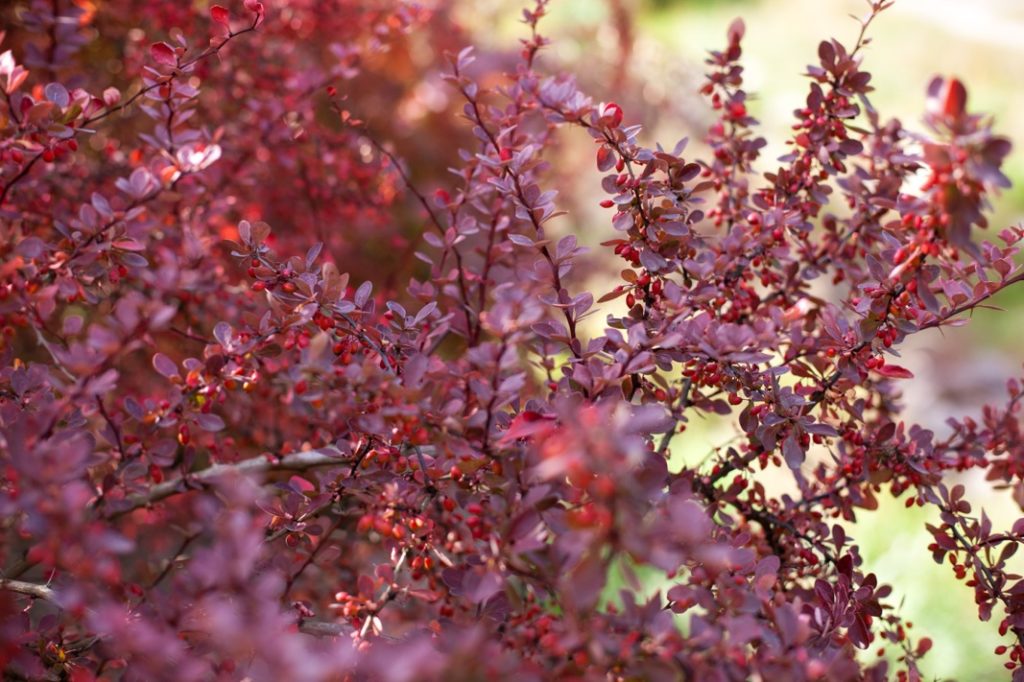
To help you start thinking about which shrub varieties with autumn berries you might choose, we’ve compiled this list of a few of the best options for an autumn yield that not only looks beautiful, but can be beneficial to you and the wildlife that shares your space.
1) Blackberry
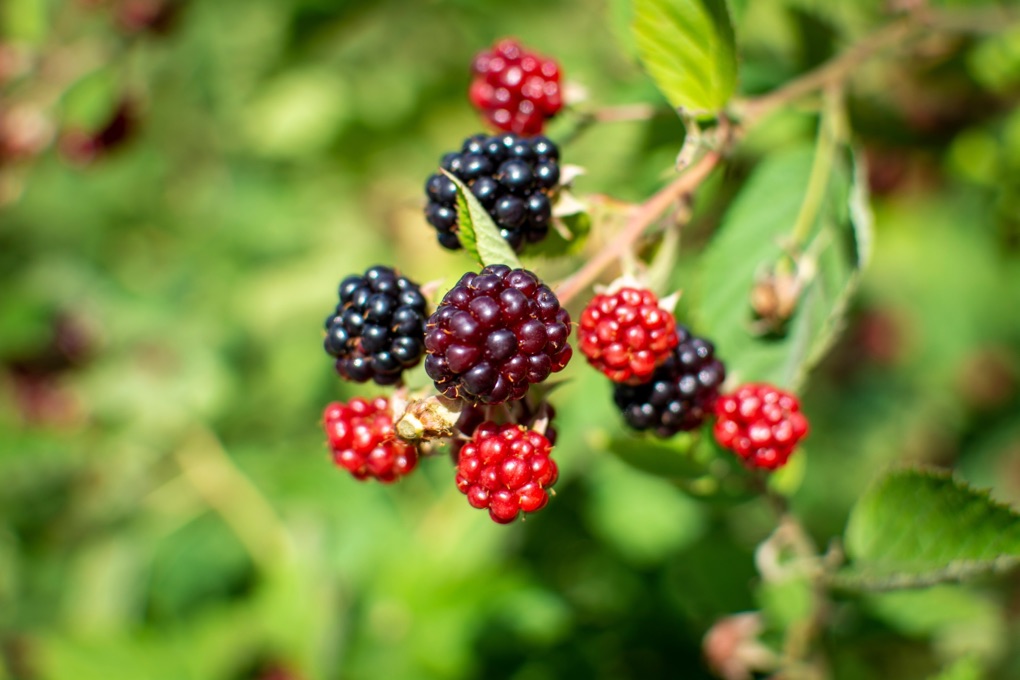
- BOTANICAL NAME: Rubus fruticosus agg.
- HARDINESS RATING: H6
- FOLIAGE TYPE: Deciduous
- FLOWERING SEASON(S): Summer
- FRUIT SEASON(S): Autumn
One of the best-known forage berries of the late summer and autumn is the blackberry.
Brambles might not be everyone’s favourite and are sometimes considered to be a bane for gardeners due to their spiny tangles and rampant growth.
However, blackberries can thrive in a huge range of settings, meaning they can be a good choice for problematic sites.
While an overgrown bramble thicket might sometimes seem unsightly to gardeners who like things neat and tidy, they can provide an abundance of free food, for you and for wildlife, who will also appreciate the shelter blackberry bushes can provide.
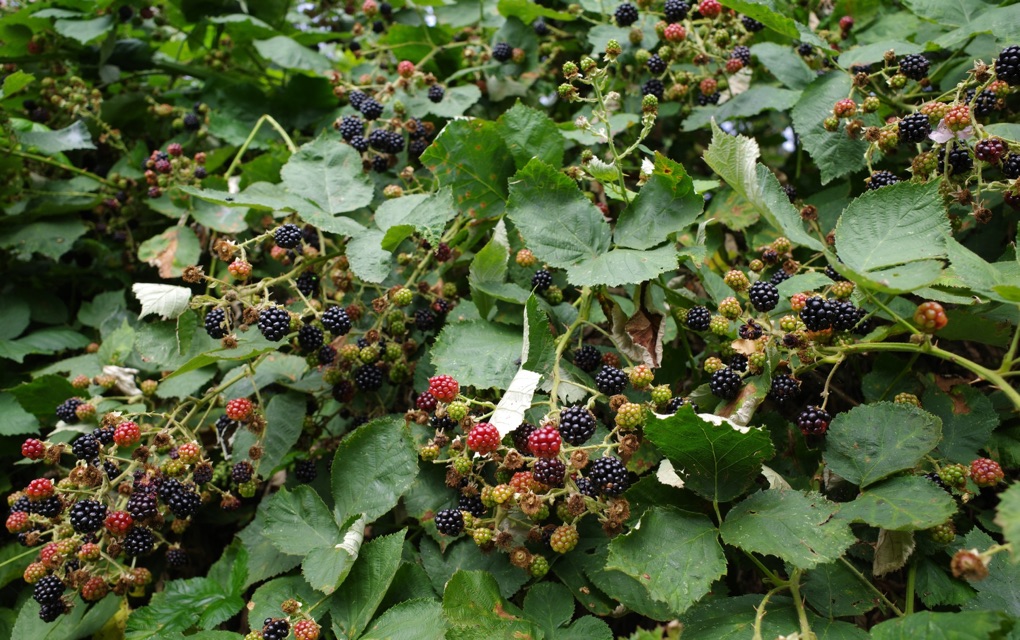
Remember, blackberries can be trained and kept somewhat in check and if the spines are too off-putting, there are now thornless cultivars that you can buy.
These are a lot easier to care for and tend without having to don gauntlets and feel like you are going into battle.
If your garden is of a reasonably large size and you want autumn interest, a wildlife-friendly garden and want to grow your own food easily at home, blackberries are definitely a shrub to consider.
They can look good in a somewhat wilder and more natural corner of a space.
2) Elderberry
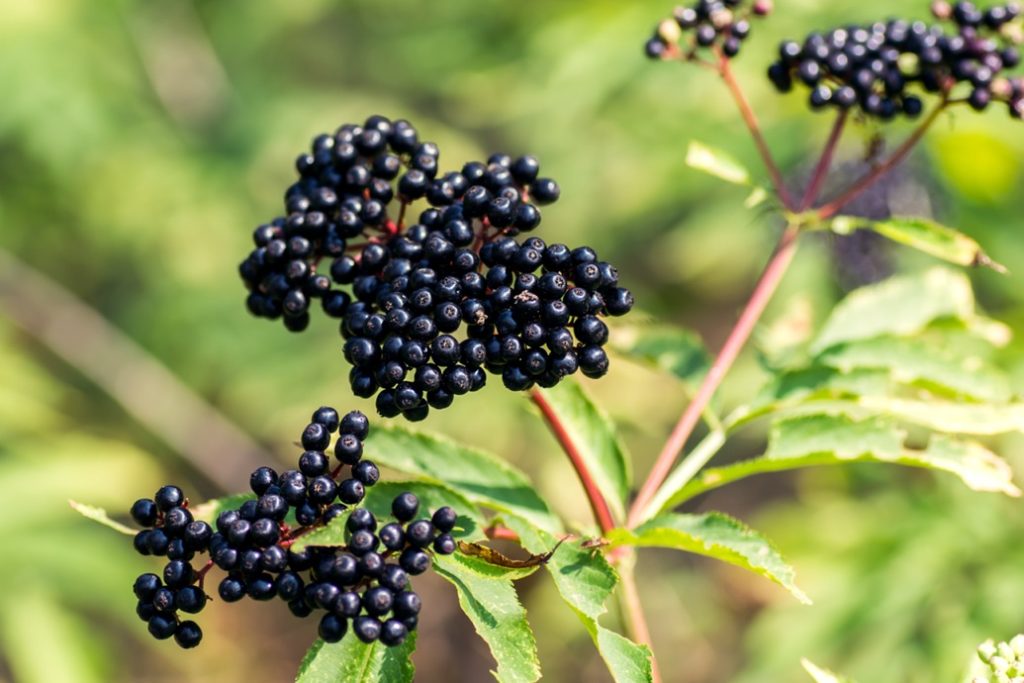
- BOTANICAL NAME: Sambucus nigra
- HARDINESS RATING: H6
- FOLIAGE TYPE: Deciduous
- FLOWERING SEASON(S): Summer
- FRUIT SEASON(S): Autumn
Elderberry is another berry-bearing shrub which can be so successful that it almost becomes a weed in some settings.
However, this is another great shrub to consider for an abundant and wildlife-friendly space.
Earlier in the year, the elder blossoms also provide a useful yield, but if you leave plenty on the plant, the beautiful deep-coloured berries will develop by autumn.
These berries can be cooked and used in a number of different ways.
You can make an elderberry jelly or jam, or you can mix elderberries with other autumn fruits in a range of preserves.
3) Hawthorn
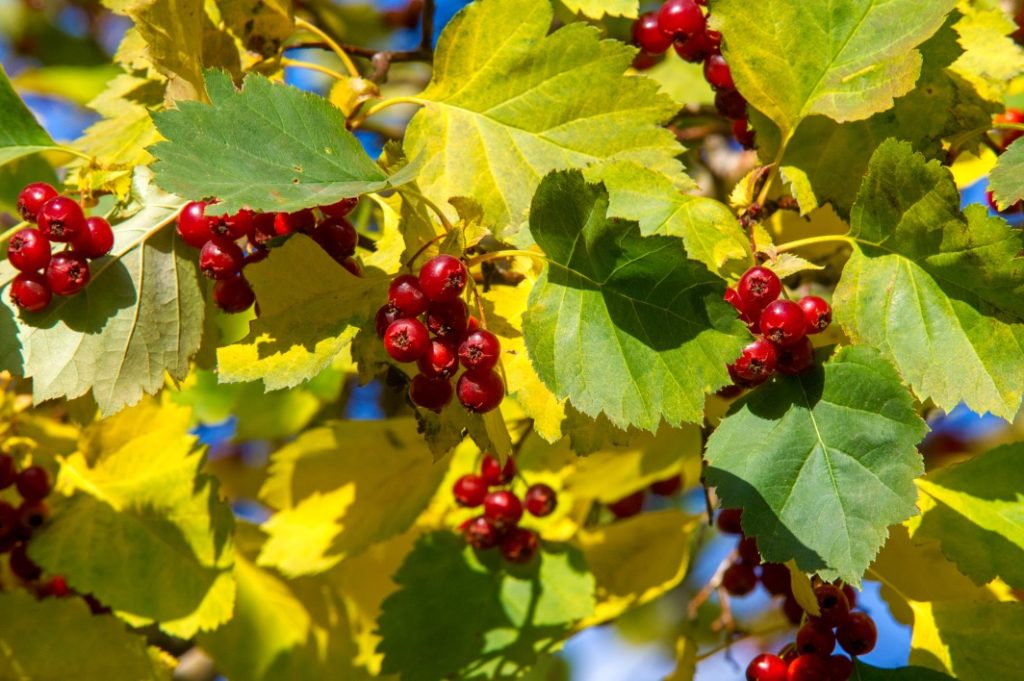
- BOTANICAL NAME: Crataegus monogyna
- HARDINESS RATING: H7
- FOLIAGE TYPE: Deciduous
- FLOWERING SEASON(S): Spring
- FRUIT SEASON(S): Autumn
A well-known native shrub or small tree, the hawthorn is a well-known hedgerow shrub, but many people today are not aware that hawthorns are not only ornamental but also provide edible yields.
The young leaves when they first emerge are a hedgerow delicacy, and the berries, or haws, are also edible.1Foraging Guide Hawthorn. (n.d.). Foraging Course Site. Retrieved March 23, 2023, from https://www.foragingcoursecompany.co.uk/foraging-guide-hawthorn
They are delicious when cooked into jams or other preserves.
The fruits can also be dried, ground, mixed with flour and used in bread baking.
Hawthorn is a great choice for hedgerows in many settings, even in exposed locations.
It can thrive in many soil types, including heavy clay and nutritionally poor conditions, and is unfussy about soil pH.
The hawthorn is also known for attracting and aiding a range of native wildlife.
“Hawthorn is fantastic for wildlife and hums with it from spring to autumn,” shares Master Horticulturist Colin Skelly.
“The autumn berries on the trees in my garden are stripped by birds and the density of the crowns supports multiple nests.”
4) Barberry
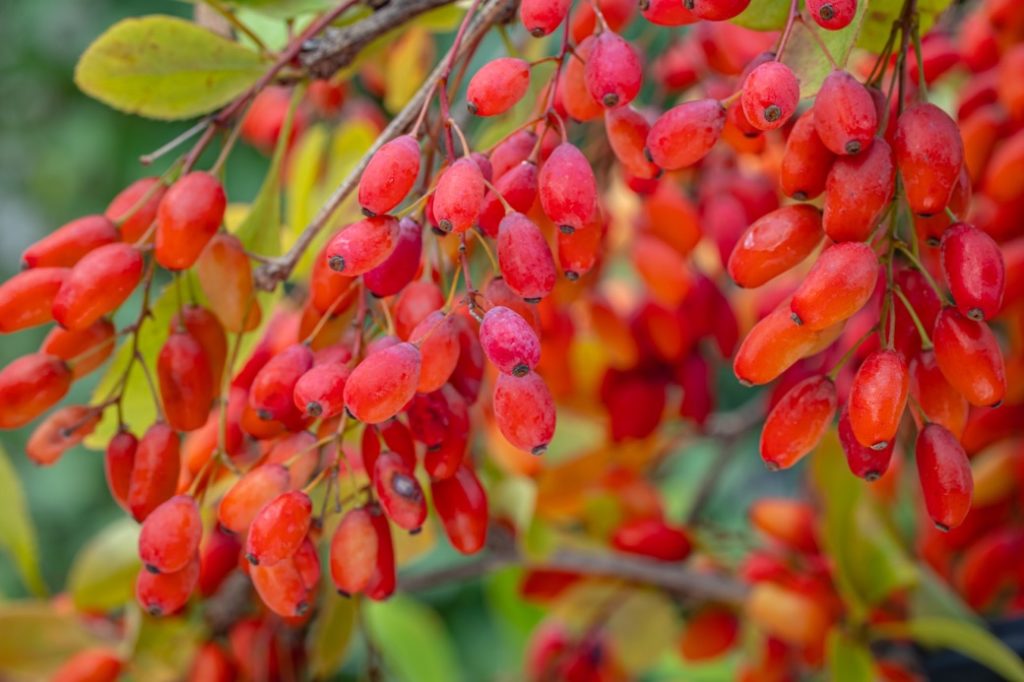
- BOTANICAL NAME: Berberis vulgaris
- HARDINESS RATING: H7
- FOLIAGE TYPE: Deciduous
- FLOWERING SEASON(S): Spring/Summer
- FRUIT SEASON(S): Summer/Autumn
There are a number of different types of Berberis, or barberry, with edible autumn berries.
These shrubs can be another attractive and useful addition to a garden.
There are several named cultivars known for their berries and today, the common barberry is best known as an ornamental garden plant, despite it first being cultivated for its edible yield.
Other evergreen types like Berberis darwinii, for example, also have berries with edible uses.2Berberis darwinii. (n.d.-c). Plants for a Future. Retrieved March 23, 2023, from https://pfaf.org/user/plant.aspx?LatinName=Berberis+darwinii
The berries are very acidic, so most people prefer to use these fruits in jams and other preserves.
5) Sea Buckthorn

- BOTANICAL NAME: Hippophae rhamnoides
- HARDINESS RATING: H7
- FOLIAGE TYPE: Deciduous
- FLOWERING SEASON(S): Spring
- FRUIT SEASON(S): Summer
Another interesting shrub to consider growing in your garden for autumn interest and its berries is sea buckthorn.
One of the notable and useful things about this tolerant shrub is that it is a nitrogen fixer – so can help you maintain fertility in the soil of your garden over time.
They can be a particularly good choice for hedgerows or windbreaks in coastal locations.
While usually too acidic to enjoy eating when raw, they are often juiced and used in drinks alongside other autumn fruits, or cooked and used in a range of recipes.3Harford, R. (2023, January 27). Sea Buckthorn. Eat Weeds. Retrieved March 23, 2023, from https://www.eatweeds.co.uk/sea-buckthorn-elaeagnus-rhamnoides
6) Elaeagnus ssp.
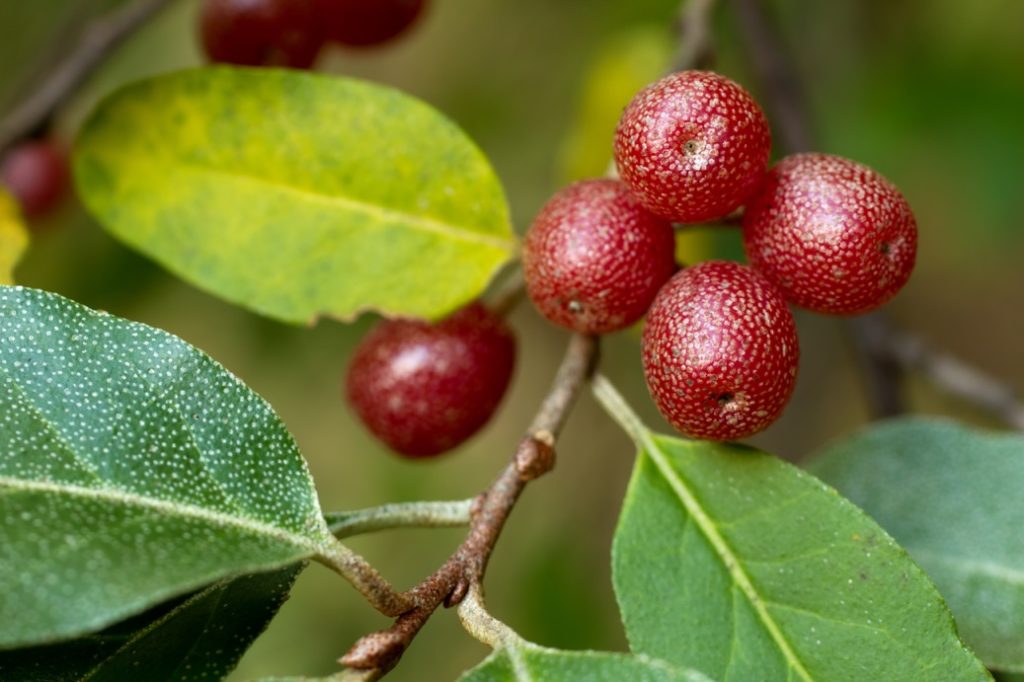
- COMMON NAME(S): Thorny olive
- HARDINESS RATING: H6
- FOLIAGE TYPE: Deciduous
- FLOWERING SEASON(S): Spring
- FRUIT SEASON(S): Autumn
Elaeagnus ssp. are other useful nitrogen-fixing shrubs that can also provide edible berries.
Examples include E. umbellata, also known as autumn olive, which has red fruits in the autumn months that are usually cooked and made into jams and other preserves.4Lord, B. (2013, September 9). Untold Abundance: The Autumn Olive. Northern Woodlands. Retrieved March 23, 2023, from https://northernwoodlands.org/knots_and_bolts/autumn-olive
Elaeagnus subspecies can make great informal hedgerows, and also work well within forest garden schemes.
It is said to increase the productivity of fruit trees by 10%.5Black, B., Fordham, I., & Perkins, P. (2005, July). Autumnberry (Elaeagnus umbellata): A potential cash crop. Research Gate. Retrieved March 23, 2023, from https://www.researchgate.net/publication/266614870_Autumnberry_Elaeagnus_umbellata_A_potential_cash_crop
There are also several other Elaeagnus shrubs which fruit in autumn and provide other benefits through nitrogen fixation to the soil and neighbouring plants.
7) Viburnum opulus
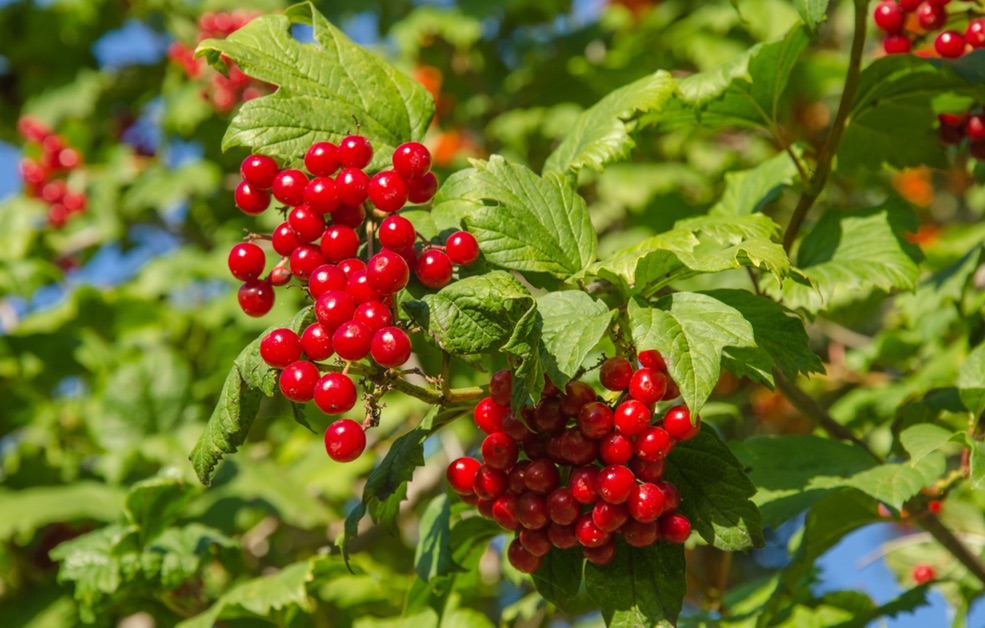
- COMMON NAME(S): Guelder rose
- HARDINESS RATING: H6
- FOLIAGE TYPE: Deciduous
- FLOWERING SEASON(S): Spring/Summer
- FRUIT SEASON(S): Autumn
The native guelder rose, or Viburnum opulus, looks wonderful over a long season of interest.
As a native plant, it can be a good choice for native wildlife-friendly gardens.
The berries can be used in moderation as a cranberry substitute.6American Cranberrybush. (2020, November 26). The Natural Web. Retrieved March 23, 2023, from https://the-natural-web.org/2020/11/26/american-cranberrybush/
A yellow-berried version ‘Xanthocarpum’ has attractive golden yellow berries in autumn, which last well into winter before being eaten by native birds.
8) Juniper

- BOTANICAL NAME: Juniperus communis
- HARDINESS RATING: H7
- FOLIAGE TYPE: Deciduous
- FLOWERING SEASON(S): Spring
- FRUIT SEASON(S): Autumn
Another native plant, the common Juniper can also bear autumn berries, which are typically used in making gin.7Juniper is the one botanical required for gin to be gin. (n.d.). The GIN Is IN. Retrieved March 23, 2023, from https://theginisin.com/botanicals-list/juniper/
Even if you do not plan on using the berries, a Juniper bush can also be an attractive evergreen addition to your garden which can keep it looking good all year round.
This is a great plant for wildlife too.
9) Aronia melanocarpa
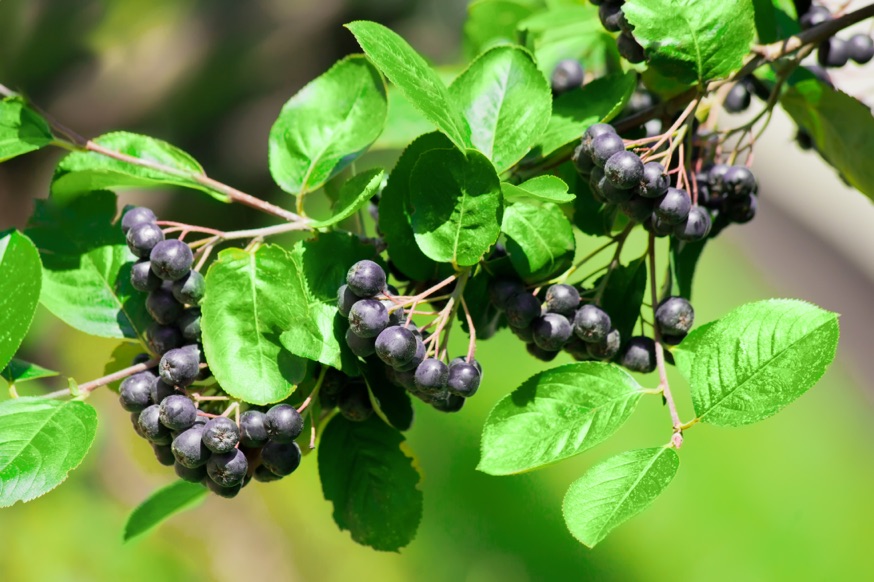
- COMMON NAME(S): Black chokeberry
- HARDINESS RATING: H6
- FOLIAGE TYPE: Deciduous
- FLOWERING SEASON(S): Spring/Summer
- FRUIT SEASON(S): Autumn
For forest garden schemes, one other useful autumn berry shrub to consider growing is Aronia melanocarpa, also known as the black chokeberry.
This North American native grows well in partial or dappled shade below trees, or in the sun.
The fruits are left until fully ripe and are best after a couple of frosts and can be added to jams to help them set.8Bergo, A. (2020, January 20). Simple Chokeberry / Aronia Preserves or Jam. Forager | Chef. Retrieved March 23, 2023, from https://foragerchef.com/simple-chokeberry-aronia-preserves/
Aronia also has foliage with amazing autumn colour.
10) Gaultheria shallon

- COMMON NAME(S): Shallon/salal
- HARDINESS RATING: H5
- FOLIAGE TYPE: Evergreen
- FLOWERING SEASON(S): Summer
- FRUIT SEASON(S): Summer/Autumn
Gaultheria shallon, also known as shallon or salal, is another North American native, though it has occasionally naturalised in Britain.
This evergreen shrub is another good choice for a forest garden type scheme, as it can grow well in dappled and even somewhat deeper woodland shade.
The fruits can be made into preserves or dried and used like raisins.
The fruits appear in late summer or early autumn.
11) Beautyberry
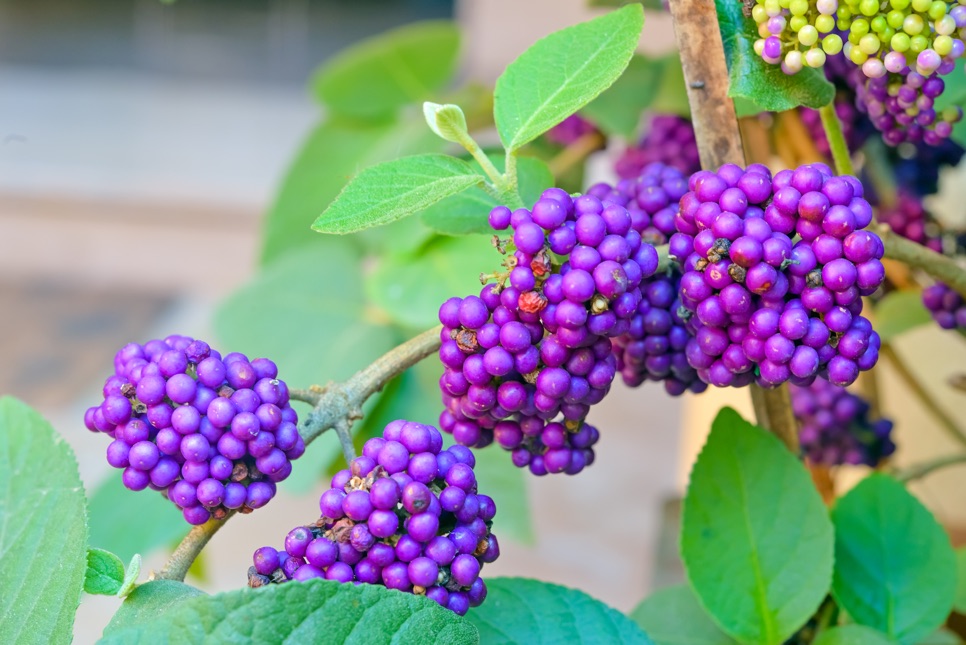
- BOTANICAL NAME: Callicarpa americana
- HARDINESS RATING: H5
- FOLIAGE TYPE: Deciduous
- FLOWERING SEASON(S): Summer
- FRUIT SEASON(S): Autumn
Another more unusual shrub with autumn berries to consider is Beautyberry, or Callicarpa americana.
The main reason to grow this and other Callicarpa is not so much for eating, but rather for the unusual appearance of the purple berries, which can be highly aesthetically appealing.
One Callicarpa with ornamental appeal is Callicarpa bodinieri var. giraldii ‘Profusion’, which bears a profusion of the unusual bright, light purple berries.
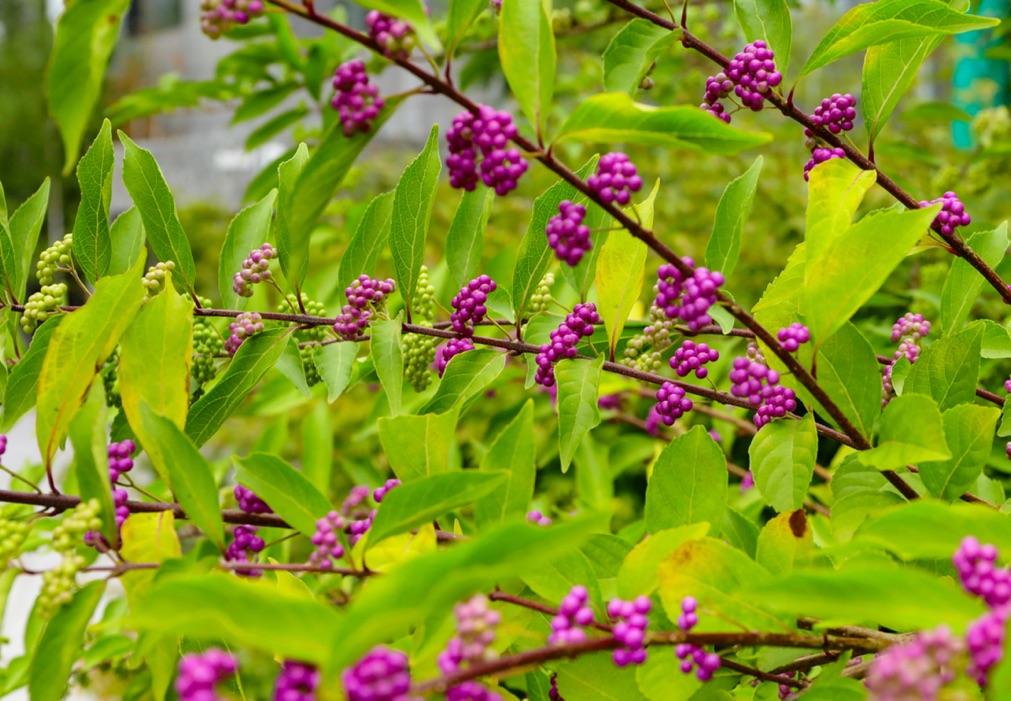
There are, of course, plenty of other ornamental berry bushes to consider for autumn berries and autumn interest, but these options mentioned above could be a good place to start when choosing shrubs for your autumn garden.
Also, don’t forget about other autumn fruits, from rose hips, to crab apples, to sloes and bullaces, that you could consider growing in your garden to add further to your autumn foraging fare.
Where To Plant Your Autumn Berry Shrubs
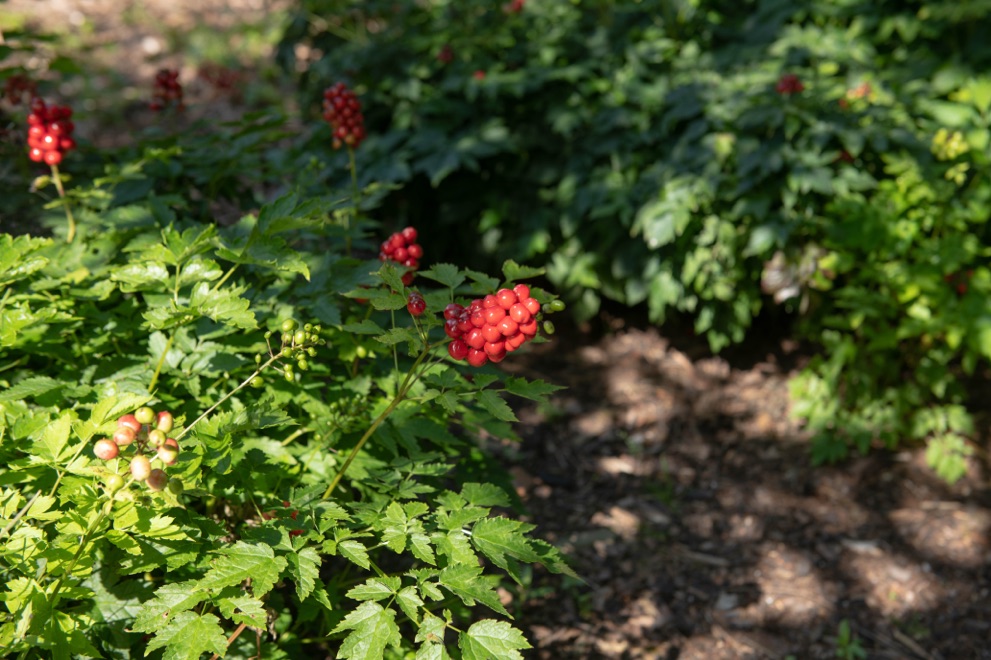
Perennial gardens can take a range of forms.
Shrub varieties for autumn berries can be integrated into perennial borders, perhaps alongside some perennial vegetables as well as some herbaceous perennial flowers.
You can use them as part of a mixed hedgerow scheme along a garden border or to divide garden rooms.
They can also be placed around fruit trees in a food forest design with layered planting, which provides many yields while all the plants and other elements work together harmoniously, like a natural forest or woodland.
Such schemes can be useful no matter how large or small your garden may be.
A single fruit tree and a single shrub for autumn berries can considerably enrich even the smallest of spaces – some can even be grown in a container garden.
References
- 1Foraging Guide Hawthorn. (n.d.). Foraging Course Site. Retrieved March 23, 2023, from https://www.foragingcoursecompany.co.uk/foraging-guide-hawthorn
- 2Berberis darwinii. (n.d.-c). Plants for a Future. Retrieved March 23, 2023, from https://pfaf.org/user/plant.aspx?LatinName=Berberis+darwinii
- 3Harford, R. (2023, January 27). Sea Buckthorn. Eat Weeds. Retrieved March 23, 2023, from https://www.eatweeds.co.uk/sea-buckthorn-elaeagnus-rhamnoides
- 4Lord, B. (2013, September 9). Untold Abundance: The Autumn Olive. Northern Woodlands. Retrieved March 23, 2023, from https://northernwoodlands.org/knots_and_bolts/autumn-olive
- 5Black, B., Fordham, I., & Perkins, P. (2005, July). Autumnberry (Elaeagnus umbellata): A potential cash crop. Research Gate. Retrieved March 23, 2023, from https://www.researchgate.net/publication/266614870_Autumnberry_Elaeagnus_umbellata_A_potential_cash_crop
- 6American Cranberrybush. (2020, November 26). The Natural Web. Retrieved March 23, 2023, from https://the-natural-web.org/2020/11/26/american-cranberrybush/
- 7Juniper is the one botanical required for gin to be gin. (n.d.). The GIN Is IN. Retrieved March 23, 2023, from https://theginisin.com/botanicals-list/juniper/
- 8Bergo, A. (2020, January 20). Simple Chokeberry / Aronia Preserves or Jam. Forager | Chef. Retrieved March 23, 2023, from https://foragerchef.com/simple-chokeberry-aronia-preserves/
